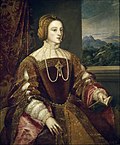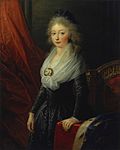| Descendant | Image | Birth | Marriages | Death |
|---|
Infanta Isabel
1503–1539 |  | 24 October 1503
Lisbon
daughter of Manuel I and Maria of Aragon and Castile | Charles V, Holy Roman Emperor
10 March 1526
5 children | 1 May 1539
Toledo
aged 35 |
Philip I of Portugal, II of Spain
1527–1598 |  | 21 May 1527
Valladolid
son of Isabella of Portugal and Charles V, Holy Roman Emperor | Maria Manuel of Portugal
14 November 1543
1 child
Mary I of England
25 July 1554
no children
Elisabeth of Valois
22 June 1559
2 children
Anna of Austria
24 January 1570
4 children | 13 September 1598
El Escorial
aged 71 |
Carlos, Prince of Asturias
1545–1568 |  | 8 July 1545
Valladolid
son of Philip I of Portugal, II of Spain and Maria Manuel of Portugal | never married | 24 July 1568
Madrid
aged 23 |
Philip II of Portugal, III of Spain
1578–1621 |  | 14 April 1578
Madrid
son of Philip I of Portugal, II of Spain and Anna of Austria | Margaret of Austria
18 April 1599
8 children | 31 March 1621
Madrid
aged 42 |
Philip III of Portugal, IV of Spain
1605–1665 |  | 8 April 1605
Valladolid
son of Philip II of Portugal, III of Spain and Margaret of Austria | Elisabeth of France
25 November 1615
7 children
Mariana of Austria
7 Octobre 1649
5 children | 17 September 1665
Madrid
aged 60 |
Baltasar Carlos, Prince of Asturias and Portugal
1629–1646 |  | 17 October 1629
Madrid
son of Philip III of Portugal, IV of Spain and Elisabeth of France | never married | 9 October 1646
Zaragoza
aged 16 |
Philip Prospero, Prince of Asturias
1657–1661 |  | November 28, 1657
Madrid
son of Philip III of Portugal, IV of Spain and Mariana of Austria | never married | November 1, 1661
Madrid
aged 3 |
Charles II of Spain
1661–1700 |  | 6 November 1661
Madrid
son of Philip III of Portugal, IV of Spain and Mariana of Austria | Marie Louise of Orléans
30 August 1679
no children
Maria Anna of Neuburg
28 August 1689
no children | 1 November 1700
Madrid
aged 38 |
John of Austria
1629–1679 |  | 7 April 1629
Madrid
son of Philip III of Portugal, IV of Spain and María Calderón | never married | 17 September 1679
Madrid
aged 50 |
Maria Theresa of Spain
1638–1683 |  | 10 September 1638
Madrid
daughter of Philip III of Portugal, IV of Spain and Elisabeth of France | Louis XIV of France
9 June 1660
6 children | 30 July 1683
Versailles
aged 44 |
Louis, Dauphin of France
1661–1711 |  | 1 November 1661
Fontainebleau
son of Maria Theresa of Spain and Louis XIV of France | Maria Anna of Bavaria
28 January 1680
3 children
Marie Émilie of Choin
1695
no children | 14 April 1711
Meudon
aged 49 |
Louis, Duke of Burgundy
1682–1712 |  | 16 August 1682
Versailles
son of Louis, Dauphin of France and Maria Anna of Bavaria | Marie Adélaïde of Savoy
6 December 1697
3 children | 18 February 1712
Marly-le-Roi
aged 29 |
Louis, Duke of Brittany
1707–1712 |  | 8 January 1707
Versailles
son of Louis, Duke of Burgundy and Marie Adélaïde of Savoy | never married | 8 March 1712
Versailles
aged 5 |
Louis XV of France
1710–1774 |  | 15 February 1710
Versailles
son of Louis, Duke of Burgundy and Marie Adélaïde of Savoy | Marie Leszczyńska
5 September 1725
10 children | 10 May 1774
Versailles
aged 64 |
Louis, Dauphin of France
1729–1765 |  | 4 September 1729
Versailles
son of Louis XV and Marie Leszczyńska | Maria Teresa of Spain
18 December 1744
1 child
Maria Josepha of Saxony
9 February 1747
8 children | 20 December 1765
Fontainebleau
aged 36 |
Louis XVI of France
1754–1793 |  | 23 August 1754
Versailles
son of Louis, Dauphin of France and Maria Josepha of Saxony | Marie Antoinette of Austria
16 May 1770
4 children | 21 January 1793
Paris
aged 38 |
Louis, Dauphin of France
1781–1789 |  | 22 October 1781
Versailles
son of Louis XVI and Marie Antoinette of Austria | never married | 4 June 1789
Meudon
aged 7 |
Louis XVII of France
1785–1795 |  | 27 March 1785
Versailles
son of Louis XVI and Marie Antoinette of Austria | never married | 8 June 1795
Paris
aged 10 |
Marie Thérèse of France
1778–1851 |  | 19 December 1778
Versailles
daughter of Louis XVI and Marie Antoinette of Austria | Louis, Duke of Angoulême
10 June 1799
no children | 19 October 1851
Nova Gorica
aged 72 |








































































